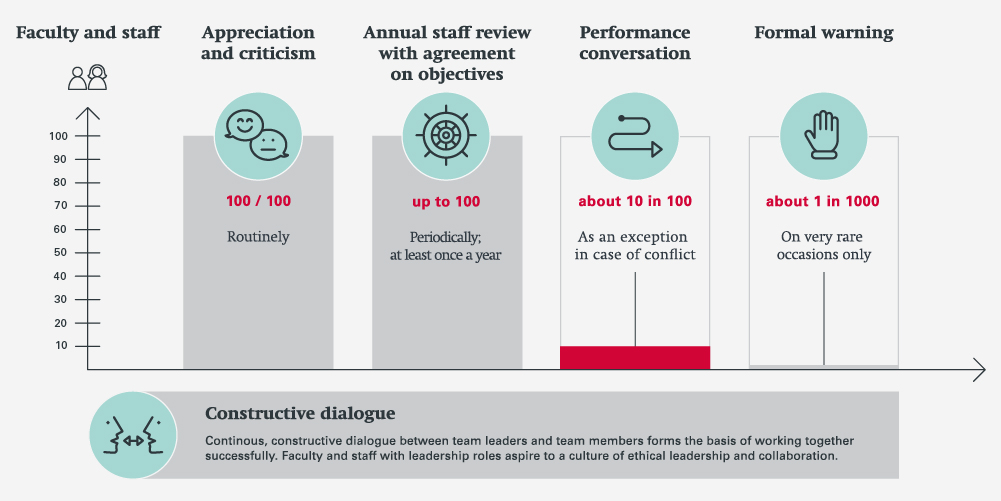Performance Conversation

In case of difficulties and conflicts in collaboration or of poor performance by a team member, team leaders are encouraged to request to meet the person for a performance conversation.
If a team member does not respond to criticisms or suggestions and improve a poor attitude or poor performance, team leaders are encouraged to request a performance conversation with the person. In a performance conversation, team leaders give concise and clear examples of their objections and point out exactly what needs to be improved.
Team members then have the opportunity to make suggestions and propose a plan of action to improve their performance or behavior. Team members are thus given a chance to save face and improve their performance. The team leader and team member then decide on the best course of action, document the course of action in a signed statement, and define deadlines and objectives for the team member to fulfill. These documents are confidential. The team leader and team member can refer back to them to gauge the degree of improvement or change in behavior. Should a conflict ensue, team leaders can consult this documentation and cite it. For these rare occasions, it may also be advisable to store the documentation in the personnel file at central HR.
Written documentation of performance conversations need not be forwarded to central HR. It might be useful, though to get in touch with Leadership & Development and/or HR at an early stage of a possible conflict, to get their support in dealing with it.
Support and coaching
Team leaders and team members may consult with the Leadership & Development coaches to find constructive ways to resolve conflicts and prevent misunderstandings.
Instructions for use Performance Conversation
Prepare
-
What about the team member’s behavior or performance is objectionable?
-
Explain concisely and clearly what exactly needs to be changed or improved.
-
Describe the kind of behavior or result you want the team member to achieve in a fair and transparent way.
Have an open conversation
-
Present your observations and objections respectfully.
-
Be fair, transparent, and concise in your description.
Listen
-
Allow the team member to illustrate his or her point of view.
-
Listen attentively to what the team member has to say.
-
If neccessary, redirect the team member back to the issue at hand.
Invite the team member to find a solution
-
Give the team member a chance to save face and make good on their performance or behavior.
-
Allowing the team member to find a workable solution improves the chances for sustained implementation of the change.
Follow up if necessary
-
Are any further steps necessary? Does the team member need support to implement the changes?
-
Who is responsible for which of the changes agreed on?
Document the conversation
-
Document the results so that the team leader and team member can refer back to them.
-
Keywords and notes suffice.
-
Should you want to make more extensive documentation, use the form in chapter 11 of the PDF provided.
-
Extensive documentation (with the PDF provided on this website) is stored in central HR’s electronic personnel folder.
-
In case of labor disputes between the University of Basel and the team member or team leader, all parties and Legal Services may refer to the centrally stored documentation


